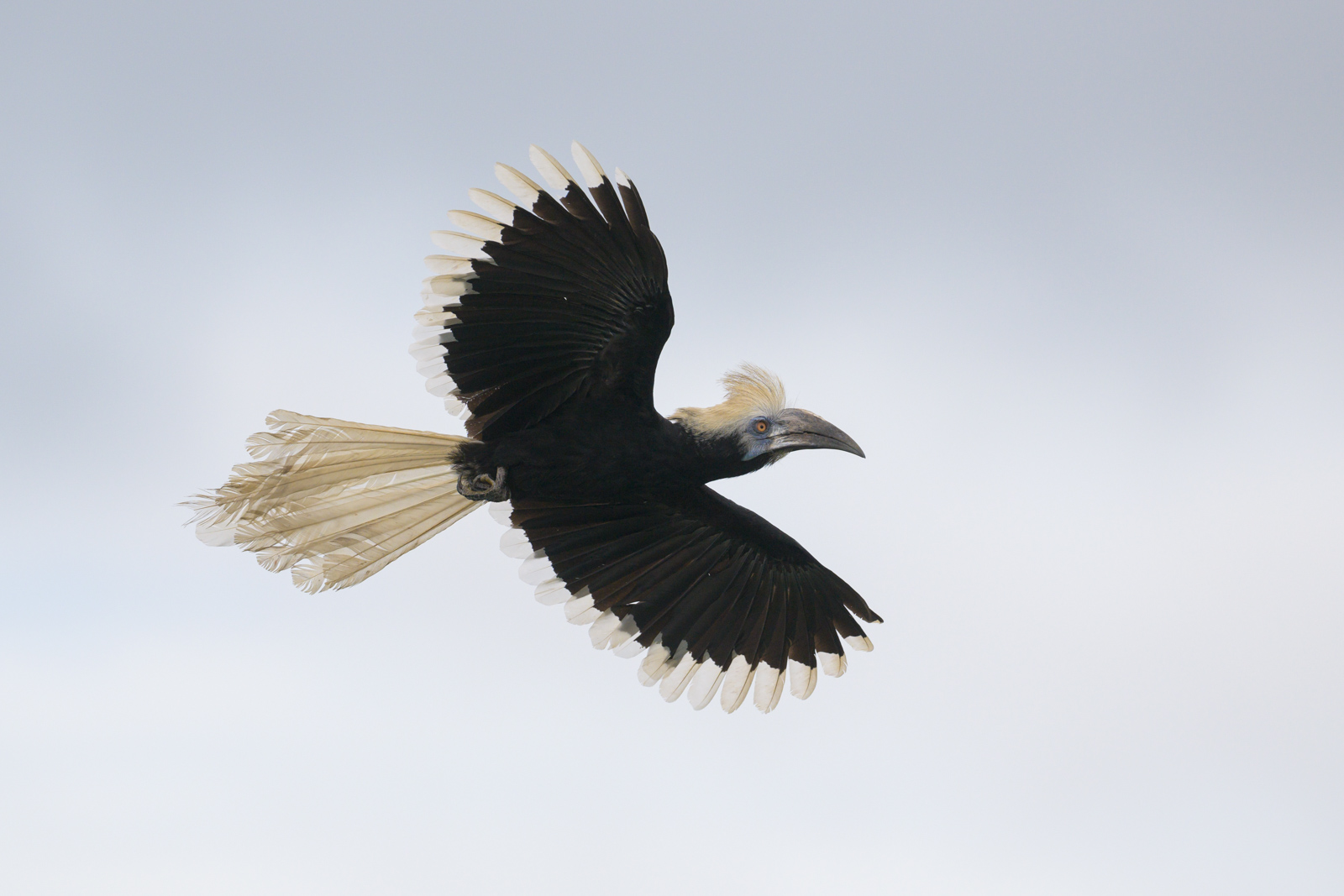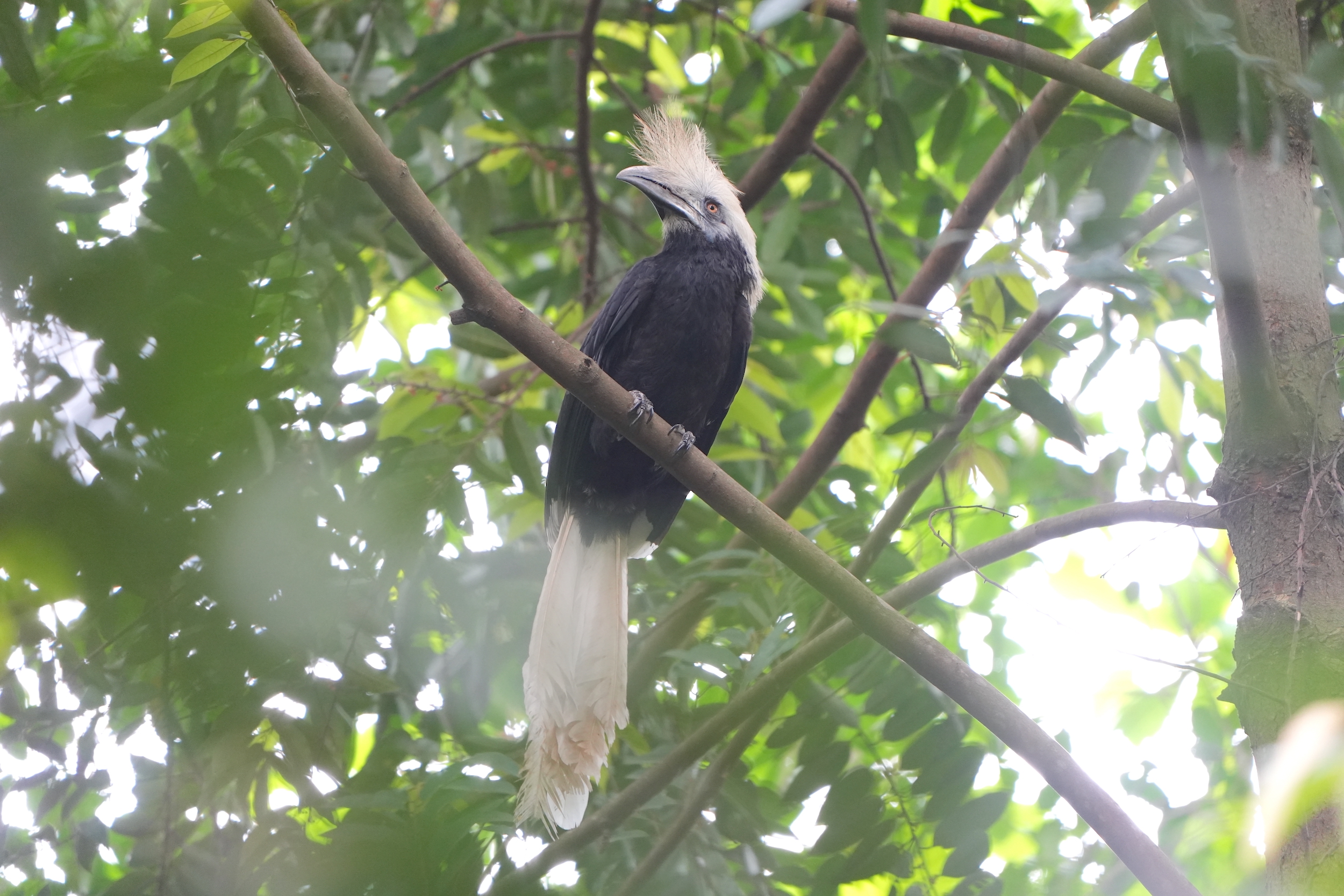By Raghav Narayanswamy
In November 2022, word of a Black-headed Ibis at Sungei Buloh Wetland Reserve was spreading through birding circles like wildfire. Over six months later, we have another species previously recorded as an escapee, this time seen at Chek Jawa – the White-crowned Hornbill Berenicornis comatus. Kiri Zhang’s quick alert meant many were able to rush down and see the bird the same day, and despite some disappointing days when it wasn’t sighted, the bird seems to be still wandering around Chek Jawa today.
Our Records Committee’s deliberations led us to the unanimous conclusion that this was likely a wild bird, although this was by no means a straightforward decision.
The identification was never in doubt. The entirely white tail and white crown rule out all other hornbill species in the region. The bigger question then – is it more likely to be a wild bird, a genuine visitor from Malaysia, or an escapee from someone’s collection? The RC’s discussions centred around a few issues which are summarized below.
Where does this species occur usually?
This is a typical Sundaic species, ranging from the forests of Kaeng Krachan in Phetchaburi, Thailand, to Johor. It also occurs in Sumatra and Borneo although we could not find any records from the Riau Archipelago in Indonesia. David Wells does not list this species from Johor in his 1999 book, although there are several recent observations at both Panti and Lenggor – the linked checklists are just a few of several on eBird.
eBird range map for White-crowned Hornbill. Here is a link to the map if it does not load immediately.
How regularly does this bird occur in the pet trade?
Hornbills appear in the wildlife trade mainly for their casques but are occasionally kept as pets as well. The White-crowned Hornbill is not well-represented in TRAFFIC surveys. It’s highly possible, though, that the species occurs infrequently in the regional pet trade. But its mere presence in the pet trade does not provide a strong case for why this particular bird must be escaped – one search of Shopee in Indonesia reveals that you can find and buy nearly anything in a cage these days. Our committee always aims to objectively weigh the relative likelihoods when dealing with these records, and while frequent occurrence in the pet trade is a red flag, there is no evidence that this species is recorded particularly often in captivity.
So, does the location matter?
Chek Jawa is currently seeing its second influx of Sundaic visitors in two years. Last year, we had a Large Woodshrike, Ruby-cheeked Sunbirds, Scarlet-breasted Flowerpecker, and best of all, two Black-and-white Bulbuls visiting the same trees frequented by the hornbill. The location is developing a reputation for attracting these wandering birds, and looking at a map it’s not hard to see why; it could be deforestation in Johor, just natural dispersal, or a combination of the two, driving them southwards in search of new habitats, and Chek Jawa would be one of the first places they land on.
The location also means that a bird which escaped from captivity on the main island would need to cover some distance and make a sea crossing in order to reach Chek Jawa in the first place. This strengthens the argument for this bird being a wild bird.
What about the bird’s physical condition?
Nothing about the bird’s appearance suggests it has origins in captivity. The bird is not ringed, its bare parts show no signs of unnatural wear, and the feathers are in near-perfect condition; the tail feathers are perhaps very slightly tattered, but this is quite normal for any wild bird. Like all the other points, though, this in itself does not really prove anything, as a well-kept captive bird could theoretically be in good condition too. So this fact again merely lends a bit more credence to the argument that this bird was always wild.


What about all the other past hornbill records which have been treated as escapees?
This is really a very good question, and one we don’t know the answer to. Before this White-crowned Hornbill, Singapore has actually had several records of hornbills which have been classified as escapees.
The repeated Rhinoceros Hornbill sightings between 2004 and 2009 were accompanied by a Great Hornbill, and both birds spent several years in the Eng Neo area. Black Hornbills – at one point up to six birds, including immatures – were recorded between 1986 and 2003, mostly near the Upper Seletar/Nee Soon area. And of course, the White-crowned Hornbill was itself recorded previously, at the Singapore Botanic Gardens in 1987.
In fact, several RC members have expressed doubts over the rather liberal application of the escapee tag for many historical records – and it’s not just restricted to hornbills. A few examples of past records the RC has previously re-evaluated and finally added into the checklist include the Velvet-fronted Nuthatch, Crimson-winged Woodpecker, Orange-breasted Green Pigeon, and even Pied Kingfisher. These were generally contemporaneously treated by past records-keepers as being escapees, although they share similarities with many of the birds we consider today to be genuinely wild dispersing birds.
Last year, as a committee, we considered the Great Hornbill record from the Bukit Timah area in 2016 and 2017 and voted by a 6-2 margin to treat the record as an escapee instead of a wild bird. Part of that could be due to the species’s ecology and perhaps higher prevalence in the pet trade – see the record page for more information – but it also may be due to some degree of wariness to apply our Chek Jawa-tinted lenses of today to the past, where details of several records are rather sparse or provide few indications of why birds were considered escapees in the first place. If there were good reasons, we may indeed never know. And so while we have reviewed some past records, we felt those cases were more clear-cut inclusions in the checklist with especially strong claims for wild provenance.
With this, the White-crowned Hornbill is now the 429th species on the Singapore Bird List. If you haven’t gotten your tick yet, maybe this is the motivation you need to go down and see this new visitor to our shores!
References
Chan, Y. M., Chan, M., & Wee, Y. C. (2008). Aberrant behaviour of a female Great Hornbill and a female Rhinoceros Hornbill. Nature in Singapore, 1, 31–34. Link
Wells, D. (1999). Birds of Thai-Malay Peninsula. Academic Press.






